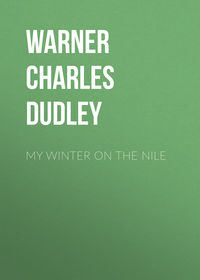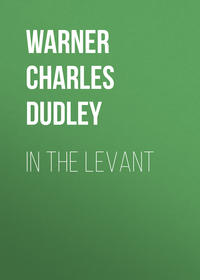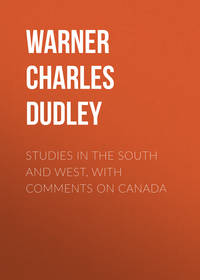 полная версия
полная версияПолная версия
Our Italy
The rainy season in Southern California, which may open with a shower or two in October, but does not set in till late in November, or till December, and is over in April, is not at all a period of cloudy weather or continuous rainfall. On the contrary, bright warm days and brilliant sunshine are the rule. The rain is most likely to fall in the night. There may be a day of rain, or several days that are overcast with distributed rain, but the showers are soon over, and the sky clears. Yet winters vary greatly in this respect, the rainfall being much greater in some than in others. In 1890 there was rain beyond the average, and even on the equable beach of Coronada there were some weeks of weather that from the California point of view were very unpleasant. It was unpleasant by local comparison, but it was not damp and chilly, like a protracted period of falling weather on the Atlantic. The rain comes with a southerly wind, caused by a disturbance far north, and with the resumption of the prevailing westerly winds it suddenly ceases, the air clears, and neither before nor after it is the atmosphere "steamy" or enervating. The average annual rainfall of the Pacific coast diminishes by regular gradation from point to point all the way from Puget Sound to the Mexican boundary. At Neah Bay it is 111 inches, and it steadily lessens down to Santa Cruz, 25.24; Monterey, 11.42; Point Conception, 12.21; San Diego, 11.01. There is fog on the coast in every month, but this diminishes, like the rainfall, from north to south. I have encountered it in both February and June. In the south it is apt to be most persistent in April and May, when for three or four days together there will be a fine mist, which any one but a Scotchman would call rain. Usually, however, the fog-bank will roll in during the night, and disappear by ten o'clock in the morning. There is no wet season properly so called, and consequently few days in the winter months when it is not agreeable to be out-of-doors, perhaps no day when one may not walk or drive during some part of it. Yet as to precipitation or temperature it is impossible to strike any general average for Southern California. In 1883-84 San Diego had 25.77 inches of rain, and Los Angeles (fifteen miles inland) had 38.22. The annual average at Los Angeles is 17.64; but in 1876-77 the total at San Diego was only 3.75, and at Los Angeles only 5.28. Yet elevation and distance from the coast do not always determine the rainfall. The yearly mean rainfall at Julian, in the San Jacinto range, at an elevation of 4500 feet, is 37.74; observations at Riverside, 1050 feet above the sea, give an average of 9.37.
It is probably impossible to give an Eastern man a just idea of the winter of Southern California. Accustomed to extremes, he may expect too much. He wants a violent change. If he quits the snow, the slush, the leaden skies, the alternate sleet and cold rain of New England, he would like the tropical heat, the languor, the color of Martinique. He will not find them here. He comes instead into a strictly temperate region; and even when he arrives, his eyes deceive him. He sees the orange ripening in its dark foliage, the long lines of the eucalyptus, the feathery pepper-tree, the magnolia, the English walnut, the black live-oak, the fan-palm, in all the vigor of June; everywhere beds of flowers of every hue and of every country blazing in the bright sunlight—the heliotrope, the geranium, the rare hot-house roses overrunning the hedges of cypress, and the scarlet passion-vine climbing to the roof-tree of the cottages; in the vineyard or the orchard the horticulturist is following the cultivator in his shirt-sleeves; he hears running water, the song of birds, the scent of flowers is in the air, and he cannot understand why he needs winter clothing, why he is always seeking the sun, why he wants a fire at night. It is a fraud, he says, all this visible display of summer, and of an almost tropical summer at that; it is really a cold country. It is incongruous that he should be looking at a date-palm in his overcoat, and he is puzzled that a thermometrical heat that should enervate him elsewhere, stimulates him here. The green, brilliant, vigorous vegetation, the perpetual sunshine, deceive him; he is careless about the difference of shade and sun, he gets into a draught, and takes cold. Accustomed to extremes of temperature and artificial heat, I think for most people the first winter here is a disappointment. I was told by a physician who had eighteen years' experience of the climate that in his first winter he thought he had never seen a people so insensitive to cold as the San Diegans, who seemed not to require warmth. And all this time the trees are growing like asparagus, the most delicate flowers are in perpetual bloom, the annual crops are most lusty. I fancy that the soil is always warm. The temperature is truly moderate. The records for a number of years show that the mid-day temperature of clear days in winter is from 60° to 70° on the coast, from 65° to 80° in the interior, while that of rainy days is about 60° by the sea and inland. Mr. Van Dyke says that the lowest mid-day temperature recorded at the United States signal station at San Diego during eight years is 51°. This occurred but once. In those eight years there were but twenty-one days when the mid-day temperature was not above 55°. In all that time there were but six days when the mercury fell below 36° at any time in the night; and but two when it fell to 32°, the lowest point ever reached there. On one of these two last-named days it went to 51° at noon, and on the other to 56°. This was the great "cold snap" of December, 1879.
It goes without saying that this sort of climate would suit any one in ordinary health, inviting and stimulating to constant out-of-door exercise, and that it would be equally favorable to that general breakdown of the system which has the name of nervous prostration. The effect upon diseases of the respiratory organs can only be determined by individual experience. The government has lately been sending soldiers who have consumption from various stations in the United States to San Diego for treatment. This experiment will furnish interesting data. Within a period covering a little over two years, Dr. Huntington, the post surgeon, has had fifteen cases sent to him. Three of these patients had tubercular consumption; twelve had consumption induced by attacks of pneumonia. One of the tubercular patients died within a month after his arrival; the second lived eight months; the third was discharged cured, left the army, and contracted malaria elsewhere, of which he died. The remaining twelve were discharged practically cured of consumption, but two of them subsequently died. It is exceedingly common to meet persons of all ages and both sexes in Southern California who came invalided by disease of the lungs or throat, who have every promise of fair health here, but who dare not leave this climate. The testimony is convincing of the good effect of the climate upon all children, upon women generally, and of its rejuvenating effect upon men and women of advanced years.
CHAPTER V
HEALTH AND LONGEVITY
In regard to the effect of climate upon health and longevity, Dr. Remondino quotes old Hufeland that "uniformity in the state of the atmosphere, particularly in regard to heat, cold, gravity, and lightness, contributes in a very considerable degree to the duration of life. Countries, therefore, where great and sudden varieties in the barometer and the thermometer are usual cannot be favorable to longevity. Such countries may be healthy, and many men may become old in them, but they will not attain to a great age, for all rapid variations are so many internal mutations, and these occasion an astonishing consumption both of the forces and the organs." Hufeland thought a marine climate most favorable to longevity. He describes, and perhaps we may say prophesied, a region he had never known, where the conditions and combinations were most favorable to old age, which is epitomized by Dr. Remondino: "where the latitude gives warmth and the sea or ocean tempering winds, where the soil is warm and dry and the sun is also bright and warm, where uninterrupted bright clear weather and a moderate temperature are the rule, where extremes neither of heat nor cold are to be found, where nothing may interfere with the exercise of the aged, and where the actual results and cases of longevity will bear testimony as to the efficacy of all its climatic conditions being favorable to a long and comfortable existence."
In an unpublished paper Dr. Remondino comments on the extraordinary endurance of animals and men in the California climate, and cites many cases of uncommon longevity in natives. In reading the accounts of early days in California I am struck with the endurance of hardship, exposure, and wounds by the natives and the adventurers, the rancheros, horsemen, herdsmen, the descendants of soldiers and the Indians, their insensibility to fatigue, and their agility and strength. This is ascribed to the climate; and what is true of man is true of the native horse. His only rival in strength, endurance, speed, and intelligence is the Arabian. It was long supposed that this was racial, and that but for the smallness of the size of the native horse, crossing with it would improve the breed of the Eastern and Kentucky racers. But there was reluctance to cross the finely proportioned Eastern horse with his diminutive Western brother. The importation and breeding of thoroughbreds on this coast has led to the discovery that the desirable qualities of the California horse were not racial but climatic. The Eastern horse has been found to improve in size, compactness of muscle, in strength of limb, in wind, with a marked increase in power of endurance. The traveller here notices the fine horses and their excellent condition, and the power and endurance of those that have considerable age. The records made on Eastern race-courses by horses from California breeding farms have already attracted attention. It is also remarked that the Eastern horse is usually improved greatly by a sojourn of a season or two on this coast, and the plan of bringing Eastern race-horses here for the winter is already adopted.
Man, it is asserted by our authority, is as much benefited as the horse by a change to this climate. The new-comer may have certain unpleasant sensations in coming here from different altitudes and conditions, but he will soon be conscious of better being, of increased power in all the functions of life, more natural and recuperative sleep, and an accession of vitality and endurance. Dr. Remondino also testifies that it occasionally happens in this rejuvenation that families which have seemed to have reached their limit at the East are increased after residence here.
The early inhabitants of Southern California, according to the statement of Mr. H. H. Bancroft and other reports, were found to be living in Spartan conditions as to temperance and training, and in a highly moral condition, in consequence of which they had uncommon physical endurance and contempt for luxury. This training in abstinence and hardship, with temperance in diet, combined with the climate to produce the astonishing longevity to be found here. Contrary to the customs of most other tribes of Indians, their aged were the care of the community. Dr. W. A. Winder, of San Diego, is quoted as saying that in a visit to El Cajon Valley some thirty years ago he was taken to a house in which the aged persons were cared for. There were half a dozen who had reached an extreme age. Some were unable to move, their bony frame being seemingly anchylosed. They were old, wrinkled, and blear-eyed; their skin was hanging in leathery folds about their withered limbs; some had hair as white as snow, and had seen some seven-score of years; others, still able to crawl, but so aged as to be unable to stand, went slowly about on their hands and knees, their limbs being attenuated and withered. The organs of special sense had in many nearly lost all activity some generations back. Some had lost the use of their limbs for more than a decade or a generation; but the organs of life and the "great sympathetic" still kept up their automatic functions, not recognizing the fact, and surprisingly indifferent to it, that the rest of the body had ceased to be of any use a generation or more in the past. And it is remarked that "these thoracic and abdominal organs and their physiological action being kept alive and active, as it were, against time, and the silent and unconscious functional activity of the great sympathetic and its ganglia, show a tenacity of the animal tissues to hold on to life that is phenomenal."
I have no space to enter upon the nature of the testimony upon which the age of certain Indians hereafter referred to is based. It is such as to satisfy Dr. Remondino, Dr. Edward Palmer, long connected with the Agricultural Department of the Smithsonian Institution, and Father A. D. Ubach, who has religious charge of the Indians in this region. These Indians were not migratory; they lived within certain limits, and were known to each other. The missions established by the Franciscan friars were built with the assistance of the Indians. The friars have handed down by word of mouth many details in regard to their early missions; others are found in the mission records, such as carefully kept records of family events—births, marriages, and deaths. And there is the testimony of the Indians regarding each other. Father Ubach has known a number who were employed at the building of the mission of San Diego (1769-71), a century before he took charge of this mission. These men had been engaged in carrying timber from the mountains or in making brick, and many of them were living within the last twenty years. There are persons still living at the Indian village of Capitan Grande whose ages he estimates at over one hundred and thirty years. Since the advent of civilization the abstemious habits and Spartan virtues of these Indians have been impaired, and their care for the aged has relaxed.
Dr. Palmer has a photograph (which I have seen) of a squaw whom he estimates to be 126 years old. When he visited her he saw her put six watermelons in a blanket, tie it up, and carry it on her back for two miles. He is familiar with Indian customs and history, and a careful cross-examination convinced him that her information of old customs was not obtained by tradition. She was conversant with tribal habits she had seen practised, such as the cremation of the dead, which the mission fathers had compelled the Indians to relinquish. She had seen the Indians punished by the fathers with floggings for persisting in the practice of cremation.
At the mission of San Tomas, in Lower California, is still living an Indian (a photograph of whom Dr. Remondino shows), bent and wrinkled, whose age is computed at 140 years. Although blind and naked, he is still active, and daily goes down the beach and along the beds of the creeks in search of drift-wood, making it his daily task to gather and carry to camp a fagot of wood.
Another instance I give in Dr. Remondino's words: "Philip Crossthwaite, who has lived here since 1843, has an old man on his ranch who mounts his horse and rides about daily, who was a grown man breaking horses for the mission fathers when Don Antonio Serrano was an infant. Don Antonio I know quite well, having attended him through a serious illness some sixteen years ago. Although now at the advanced age of ninety-three, he is as erect as a pine, and he rides his horse with his usual vigor and grace. He is thin and spare and very tall, and those who knew him fifty years or more remember him as the most skilful horseman in the neighborhood of San Diego. And yet, as fabulous as it may seem, the man who danced this Don Antonio on his knee when he was an infant is not only still alive, but is active enough to mount his horse and canter about the country. Some years ago I attended an elderly gentleman, since dead, who knew this man as a full-grown man when he and Don Serrano were play-children together. From a conversation with Father Ubach I learned that the man's age is perfectly authenticated to be beyond one hundred and eighteen years."
In the many instances given of extreme old age in this region the habits of these Indians have been those of strict temperance and abstemiousness, and their long life in an equable climate is due to extreme simplicity of diet. In many cases of extreme age the diet has consisted simply of acorns, flour, and water. It is asserted that the climate itself induces temperance in drink and abstemiousness in diet. In his estimate of the climate as a factor of longevity, Dr. Remondino says that it is only necessary to look at the causes of death, and the ages most subject to attack, to understand that the less of these causes that are present the greater are the chances of man to reach great age. "Add to these reflections that you run no gantlet of diseases to undermine or deteriorate the organism; that in this climate childhood finds an escape from those diseases which are the terror of mothers, and against which physicians are helpless, as we have here none of those affections of the first three years of life so prevalent during the summer months in the East and the rest of the United States. Then, again, the chance of gastric or intestinal disease is almost incredibly small. This immunity extends through every age of life. Hepatic and kindred diseases are unknown; of lung affections there is no land that can boast of like exemption. Be it the equability of the temperature or the aseptic condition of the atmosphere, the free sweep of winds or the absence of disease germs, or what else it may be ascribed to, one thing is certain, that there is no pneumonia, bronchitis, or pleurisy lying in wait for either the infant or the aged."
The importance of this subject must excuse the space I have given to it. It is evident from this testimony that here are climatic conditions novel and worthy of the most patient scientific investigation. Their effect upon hereditary tendencies and upon persons coming here with hereditary diseases will be studied. Three years ago there was in some localities a visitation of small-pox imported from Mexico. At that time there were cases of pneumonia. Whether these were incident to carelessness in vaccination, or were caused by local unsanitary conditions, I do not know. It is not to be expected that unsanitary conditions will not produce disease here as elsewhere. It cannot be too strongly insisted that this is a climate that the new-comer must get used to, and that he cannot safely neglect the ordinary precautions. The difference between shade and sun is strikingly marked, and he must not be deceived into imprudence by the prevailing sunshine or the general equability.
CHAPTER VI
IS RESIDENCE HERE AGREEABLE?
After all these averages and statistics, and not considering now the chances of the speculator, the farmer, the fruit-raiser, or the invalid, is Southern California a particularly agreeable winter residence? The question deserves a candid answer, for it is of the last importance to the people of the United States to know the truth—to know whether they have accessible by rail a region free from winter rigor and vicissitudes, and yet with few of the disadvantages of most winter resorts. One would have more pleasure in answering the question if he were not irritated by the perpetual note of brag and exaggeration in every locality that each is the paradise of the earth, and absolutely free from any physical discomfort. I hope that this note of exaggeration is not the effect of the climate, for if it is, the region will never be socially agreeable.
There are no sudden changes of season here. Spring comes gradually day by day, a perceptible hourly waking to life and color; and this glides into a summer which never ceases, but only becomes tired and fades into the repose of a short autumn, when the sere and brown and red and yellow hills and the purple mountains are waiting for the rain clouds. This is according to the process of nature; but wherever irrigation brings moisture to the fertile soil, the green and bloom are perpetual the year round, only the green is powdered with dust, and the cultivated flowers have their periods of exhaustion.
I should think it well worth while to watch the procession of nature here from late November or December to April. It is a land of delicate and brilliant wild flowers, of blooming shrubs, strange in form and wonderful in color. Before the annual rains the land lies in a sort of swoon in a golden haze; the slopes and plains are bare, the hills yellow with ripe wild-oats or ashy gray with sage, the sea-breeze is weak, the air grows drier, the sun hot, the shade cool. Then one day light clouds stream up from the south-west, and there is a gentle rain. When the sun comes out again its rays are milder, the land is refreshed and brightened, and almost immediately a greenish tinge appears on plain and hill-side. At intervals the rain continues, daily the landscape is greener in infinite variety of shades, which seem to sweep over the hills in waves of color. Upon this carpet of green by February nature begins to weave an embroidery of wild flowers, white, lavender, golden, pink, indigo, scarlet, changing day by day and every day more brilliant, and spreading from patches into great fields until dale and hill and table-land are overspread with a refinement and glory of color that would be the despair of the carpet-weavers of Daghestan.
This, with the scent of orange groves and tea-roses, with cool nights, snow in sight on the high mountains, an occasional day of rain, days of bright sunshine, when an overcoat is needed in driving, must suffice the sojourner for winter. He will be humiliated that he is more sensitive to cold than the heliotrope or the violet, but he must bear it. If he is looking for malaria, he must go to some other winter resort. If he wants a "norther" continuing for days, he must move on. If he is accustomed to various insect pests, he will miss them here. If there comes a day warmer than usual, it will not be damp or soggy. So far as nature is concerned there is very little to grumble at, and one resource of the traveller is therefore taken away.
But is it interesting? What is there to do? It must be confessed that there is a sort of monotony in the scenery as there is in the climate. There is, to be sure, great variety in a way between coast and mountain, as, for instance, between Santa Barbara and Pasadena, and if the tourist will make a business of exploring the valleys and uplands and cañons little visited, he will not complain of monotony; but the artist and the photographer find the same elements repeated in little varying combinations. There is undeniable repetition in the succession of flower-gardens, fruit orchards, alleys of palms and peppers, vineyards, and the cultivation about the villas is repeated in all directions. The Americans have not the art of making houses or a land picturesque. The traveller is enthusiastic about the exquisite drives through these groves of fruit, with the ashy or the snow-covered hills for background and contrast, and he exclaims at the pretty cottages, vine and rose clad, in their semi-tropical setting, but if by chance he comes upon an old adobe or a Mexican ranch house in the country, he has emotions of a different sort.
There is little left of the old Spanish occupation, but the remains of it make the romance of the country, and appeal to our sense of fitness and beauty. It is to be hoped that all such historical associations will be preserved, for they give to the traveller that which our country generally lacks, and which is so largely the attraction of Italy and Spain. Instead of adapting and modifying the houses and homes that the climate suggests, the new American comers have brought here from the East the smartness and prettiness of our modern nondescript architecture. The low house, with recesses and galleries, built round an inner court, or patio, which, however small, would fill the whole interior with sunshine and the scent of flowers, is the sort of dwelling that would suit the climate and the habit of life here. But the present occupiers have taken no hints from the natives. In village and country they have done all they can, in spite of the maguey and the cactus and the palm and the umbrella-tree and the live-oak and the riotous flowers and the thousand novel forms of vegetation, to give everything a prosaic look. But why should the tourist find fault with this? The American likes it, and he would not like the picturesqueness of the Spanish or the Latin races.







